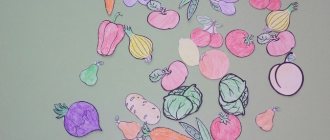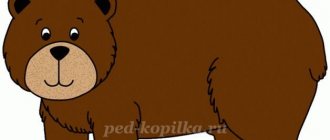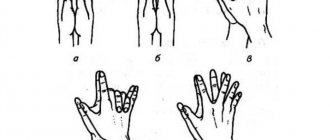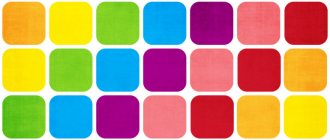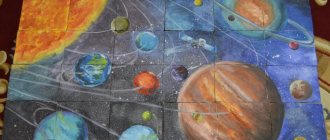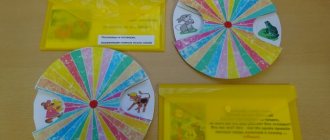Didactic game "One-many"
Didactic game “One-Many” for preschoolers 6-7 years old
We play and we develop speech.
It is known that children acquire strong knowledge, skills and abilities in the process of active cognitive activity, the most important prerequisite for which is interest.
Play plays a special role in developing interest in preschoolers. Successful speech development depends on the child’s perception of the surrounding world and objective activity. I offer a description of practical game material for the development and correction of a preschooler’s vocabulary. The use of game material will help speech therapists, educators, and parents to learn the meaning of words together with their children, acquire knowledge about the features of mastering vocabulary in a playful way, and clearly imagine the main directions of work on the formation of a dictionary. Purpose:
familiarization with game material on the formation of vocabulary in children;
Tasks:
-to form the grammatical structure of speech, the lexical system of words;
- strengthen the ability to coordinate words; - develop attention, memory, thinking, speech; Stages of work:
-familiarization with a new word;
-clarification of the meaning of the word; - consolidation of the studied material; Let's consider the game exercise “One-Many”
, aimed at developing vocabulary.
Game “One-Many” Purpose of the game:
teaching children to correctly form singular and plural nouns in speech;
Equipment:
ball, subject pictures;
Progress of the game:
the adult names the noun in the singular and throws the ball to the child; the child must throw the ball back, while naming the plural. It is advisable to play the game in the form of riddles using visual, colorful pictures.
So that you can understand me, you will have to guess the riddles. Each word has its own meaning, which is indicated by the purpose of the words. Light, airy, obedient to the wind. When inflated, it flies, and when deflated, it rests. If you hit it hard, it may burst immediately. (Ball)
(show pictures to children)
-One ball
-Many balls
The old one is small, and the new one is big.
Advertisement 14
Sometimes it is simple, sometimes it is colorful. He will help me write in a notebook, color, draw a picture. He will be with me in class, My Friend. And he is my assistant in my studies. (Pencil)
-One pencil
-Many pencils
It ripens on a tree in the garden. The taste and color of the fruit varies. Both sour and sweet - It tastes pleasant. Green, yellow, red, it’s useful! Everyone knows about it. (Apple)
- One apple
- Many apples
A multi-colored bun, He will give you a hand, He is not afraid of pain, He loves to jump and roll! Who is jumping around so merrily? - My cheerful, round one... (Ball)
- There is one ball
- There are many balls
Appeared at the neighbor's - Good hen, Bright fluffy radiant suns. Nice guys Yellow... (Chickens)
-One chicken, many chickens
MAGAZINE Preschooler.RF
Passport for the didactic game for speech development “One - Many” for children 5-7 years old with speech development disorderMunicipal state preschool educational institution of the city of Novosibirsk “Kindergarten No. 484 of a combined type” 630112, Novosibirsk, st. Selezneva, 48a, t. 224-02-13
Author-performer Yulia Mikhailovna Zaikova teacher-speech therapist of the first qualification category Novosibirsk, 2020
Title of the manual: didactic game “One - Many” .
Educational areas: cognitive development, speech development.
The need to create a manual: Currently, experts in the field of early child development insist that the development of intellectual and thinking processes must begin with the development of hand movements, and in particular with the development of movements in the fingers. This is due to the fact that the development of the hand plays an important role in the formation of the brain, its cognitive abilities and the development of speech. The development of fine motor skills is also important because the child’s entire future life will require the use of precise, coordinated movements of the hand and fingers, which are necessary to draw and glue, write, dress, and perform many different everyday and educational activities.
So what are fine motor skills?
Fine motor skills are the coordinated actions of the hands and fingers, which are performed in conjunction with the nervous, skeletal, visual and muscular systems. In other words, it is the ability to manipulate small objects using only the small muscles of the body.
Fine motor skills begin to develop from birth: first, the baby examines his hands, then learns to clench and unclench his fingers, control them in order to grab a toy or a nearby object. As he grows up, he understands how to hold a brush or pencil correctly, learns to draw, and closer to 6–7 years old he tries to write.
Lack of development of fine motor skills can lead to consequences for the child such as:
- lack of interest in drawing, modeling and other activities;
- difficulties with adaptation to the educational process at school: the child perceives new material worse, reads poorly, so the pace of learning seems too fast and difficult to him;
- insufficient development of creativity, thinking and attention;
- inability to draw a straight line or remember and write numbers or letters correctly;
- if you ask him to draw a picture, in most cases he cannot correctly place objects on the space of the sheet, he lacks imagination, there is no variety of colors and a clear plot;
- Such children begin to speak later; many have speech defects that are difficult to correct even during classes with specialists.
Poor motor skills of the fingers give poor results when performing various tasks, such as: tracing a figure, drawing according to a model, etc. The child gets tired quickly and his performance decreases. Lack of preparation for writing and insufficient development of fine motor skills can lead to a negative attitude towards learning, both in a normally developing child and in a child with special educational needs (in particular, in children with severe speech impairments).
Children with SLI often experience delays in the development of gross and fine motor skills. The technique of movements and motor qualities (dexterity, speed, accuracy, coordination) are mainly affected, and psychomotor deficiencies are revealed. Self-service skills and technical skills in visual arts are poorly developed.
In a large number of children with SLI, various forms of motor disorders are often revealed during examination. Sometimes even minor dysfunction of the mobile sphere without relevant and targeted corrective influences can lead to secondary underdevelopment of more problematic and differentiated movements and actions, which negatively affects the development of writing, drawing, design and other forms of manual activity of the child. A change (increase or decrease) in muscle tone entails exhaustion and asthenicity of the muscles of the hands. Insufficient differentiation of the innervation of the muscles of the fingers and hands makes movements awkward and prevents their coordination and smoothness. Therefore, the child cannot hold a pencil for a long time; as fatigue increases, his movements become imprecise, large-scale, or too small.
Thus, the development of fine motor skills is one of the most important tasks in teaching a child with SLI. You can develop fine motor skills in different ways: through the use of finger games, games for the development of tactile sensations, exercises for self-massage of the hands using cones, a soft ball, pencils, etc. But I think the most successful way to develop fine motor skills in preschoolers with SLI is playing with clothespins. They arouse the child’s interest and contribute to the development of not only fine motor skills, but also higher mental functions and hand-eye coordination.
The novelty of the game lies in the fact that it has a wide range of possibilities. With the help of this game, you can develop in children such a complex concept as inflection, the nominative function of speech (naming objects), expand your vocabulary, form fine motor skills and higher mental functions.
Purpose of the game: development of the nominative function of speech, formation of the ability to form word forms and lexemes that have different grammatical meanings (inflection by numbers: singular and plural).
Tasks:
- Help expand children's vocabulary.
- Form higher mental functions and hand-eye coordination.
- Develop fine motor skills of the hand.
- Develop the ability to act in accordance with the teacher’s instructions.
- Develop the nominative function of speech.
- To develop the ability to form word forms and lexemes that have different grammatical meanings (inflection by numbers: singular and plural).
Description of the manual:
The game package includes:
- Cards with tasks – 10 pcs.
- Clothespins – 20 pcs.
Progress of the game:
The teacher places a card in front of the child and asks what is shown on it. Asks the child to show one object, many objects and name them. Then he gives a clothespin and offers to pin a picture with one object or several objects.
Recommendations for using the game:
- This didactic game is intended for preschool children with SLD.
- The game “One - Many” can be used both in classes on FCCM, speech development, and in the process of independent activity of children.
- This game promotes the development of the nominative function of speech, enriching children's vocabulary, and the development of inflection.
| Next > |
Didactic game “Decompose into sets” material
Didactic game
"Decompose into sets"
Description of the material: The material is intended for children of the preparatory group, to reinforce the theme “Multiple”.
Goal: continue to introduce children to the concept of “Multiple.”
Software tasks:
- strengthen children’s ability to form sets according to certain characteristics; - develop children’s ability to identify sets with the largest, average and smallest number of elements;
- train children to distribute elements between sets that are in certain relationships with each other (union of sets, intersection of sets, subset - a set that is part of another set);
— to develop study skills;
- develop logical thinking, memory, imagination;
- fostering friendly relationships between children;
Planned result: children’s ability to identify sets, see elements and the relationship between elements of various sets. Equipment and materials:
digital educational resource “World of Informatics”, a set of objects, sheets with tasks for children, colored pencils. Procedure: - Guys, let’s play the game “Decompose into sets”. Come to me. There are objects on the table. Form sets from these objects.
- How many sets did you get? What sets are these? How many elements are in each set?
Children's answers.
- Okay, guys! Now look at these same objects again and try to form other sets.
— What sets did you get? How many elements are in each set? Children's answers.
- Conclusion: From a different set of objects, you can create a different number of sets based on common properties or characteristics. - Guys, sit down at the tables. Let's continue playing. Look at the first assignment sheet. What sets do you see here?
Children's answers.
- Now you must take a red pencil and color in the elements of the set with the largest number of elements. Which set is the largest and why? Children's answers.
— Guys, now you must find a set with an average number of elements and color these elements yellow. What set is this and why? Children's answers.
— Now find the set with the smallest number of elements and color the elements of this set green.
- Well done! Let's move on to the second task on pieces of paper.
Look: the pieces of paper depict objects and 2 intersecting circles. Each circle is a set. Read the names of the sets. Now, with arrows from each item, you must show which item should be placed in which set. Don't forget about the area of intersection of two sets.
— Guys, tell us what kind of sets you got and how many elements each set contains.
Children's answers.
- What did you place in the area of intersection of two sets and why? Children’s answers.
— Guys, you completed the tasks given to you. Let's move on to computer desks now. Tasks are already open on the desktops, where you will have to create sets of the elements offered to you. The elements are located on the right side of the screen, by clicking on the left button of the computer mouse, you must move the objects to the left side of the screen, there will be a circle or several circles symbolizing sets.
— Task 1: make up a set from the corresponding elements, which is the union of two sets - a set of fish and a set of birds.
— How many elements did you get in this set? - In this case, when combining two sets, we got a lot of living beings.
— Task 2: make up a set of living beings, selecting a subset - a set of birds.
— How many elements did you get in the multitude of birds, and how many in the multitude of living beings?
Children's answers.
- Task 3: make up a set of objects made by man, highlighting two subsets - a lot of dishes and a lot of toys.
- How many elements did you get in a variety of dishes, how many in a variety of toys, and how many in a variety of objects made by man?
Children's answers.
— Task 4: make up sets of sea inhabitants and a set of mammals, do not miss the moment that there is an area where these two sets intersect.
— How many elements did you get in the variety of sea inhabitants, and how many in the variety of mammals?
Children's answers.
How many elements did you get in the set of sea inhabitants, and how many in the set of mammals?
Children's answers.
Progress of the game.
1-2 children play . The teacher invites the playing children to take vegetables to the kindergarten to prepare lunch. Teacher: “Masha, take one carrot and 2 beets, put them in the back of the car.” The child completes the task, the teacher controls the progress of the game.
Didactic game "Big Laundry". Second junior group Didactic game “Big Laundry” second junior group Purpose: to consolidate the ability to distribute things before washing clothes by color, shape, etc.
Didactic game “Domestic and wild animals” (junior group) Today I want to offer you, dear colleagues, a didactic game “Domestic and wild animals” that allows you to consolidate the classification of animals. Didactic game “Clothes” using the “Euler Circles” model. Second junior group Today I would like to show you how my partner and I are introducing in our group the use of such a work model as “Euler Circles”. Didactic game “Screen-cube” for FEMP (senior group) Didactic game. Screen cube according to FEMP. (Senior group) This teaching aid is aimed at developing all areas of mathematical development. Didactic game “Collect beautiful nesting dolls” Second junior group. Matryoshka is beautiful, Matryoshka is sweet, Matryoshka is pleasant, How good you are! Matryoshka comes from the name Matryona. Matryoshka is a Russian wooden doll. Summary of the final lesson on FEMP “Journey to the Fairytale Forest” (second junior group) Purpose: to consolidate the concepts of many, one; train the ability to compare the number of objects: “more”, “less”, “the same”; secure. Summary of a lesson on FEMP in the junior group “Mathematical country” (one-many, shape, size, color, geometric figures) Conducted by teacher: Babaeva O. G. Notes on FEMP in the junior group on the Topic: “Mathematical country” (one -many, shape, size, color.
